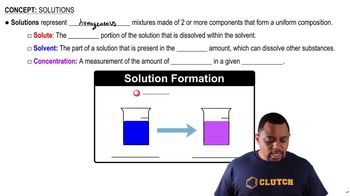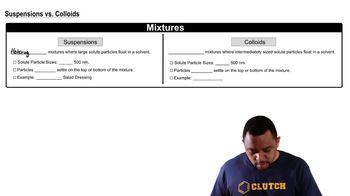Here are the essential concepts you must grasp in order to answer the question correctly.
Solution
A solution is a homogeneous mixture where one substance (the solute) is completely dissolved in another (the solvent). Solutions are characterized by their ability to pass through a semipermeable membrane, as the solute particles are typically at the molecular or ionic level, making them too small to be filtered out.
Recommended video:
Colloid
A colloid is a mixture where fine particles of one substance are dispersed within another without settling out. Colloidal particles are larger than those in a solution but smaller than those in a suspension, and they cannot be separated by a semipermeable membrane. Examples include milk and fog, where the dispersed phase remains evenly distributed.
Recommended video:
Suspension
A suspension is a heterogeneous mixture in which larger particles are dispersed in a liquid or gas but will eventually settle out over time. Unlike solutions and colloids, suspensions can be separated by filtration or a semipermeable membrane, as the particles are large enough to be trapped. Examples include muddy water and sand in water.
Recommended video:
 Verified step by step guidance
Verified step by step guidance Verified Solution
Verified Solution

